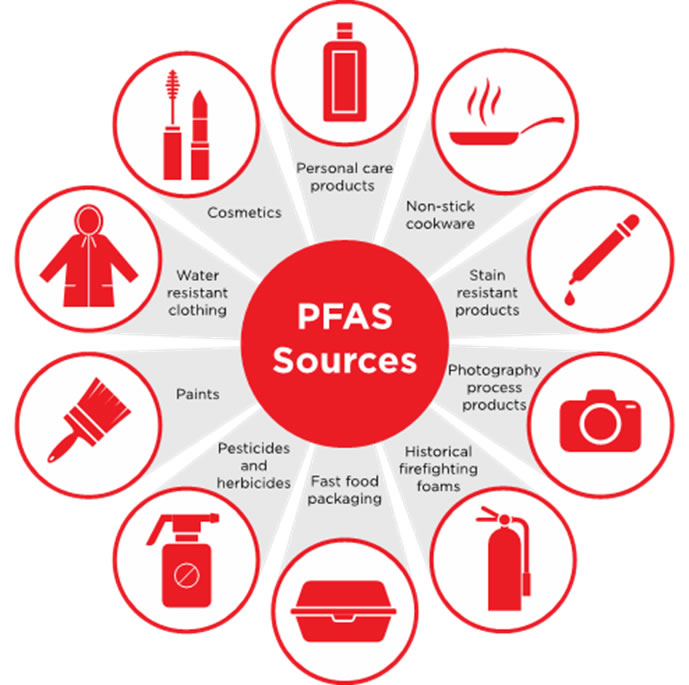About the program
What are PFAS?
PFAS (per- and poly-fluoroalkyl substances) are a group of manufactured chemicals that include perfluorooctane sulfonate (PFOS), perfluorooctanoic acid (PFOA) and perfluorohexane sulfonate (PFHxS).
PFAS are very stable chemicals that do not easily break down and can persist in the environment.
PFAS compounds have been used in the manufacture of many common household and industrial goods (as shown in the diagram below), as well as historically in certain types of firefighting foams.
These common household and industrial goods include, but are not limited to, stain resistant applications for furniture and carpets, non-stick cookware, fast food or packaged food containers, make up, personal care products, paints, and cleaning products.
Products containing PFAS are being phased out around the world. However due to their widespread use, and persistence in the environment, most people living in developed nations will likely have some level of PFOS and PFOA present in their bodies.

PFAS and Firefighting Foam
Aqueous film forming foam (AFFF) was historically used as a firefighting foam extensively worldwide, including within Australia. The use of AFFF by both civilian and military authorities as a firefighting foam commenced in the 1970s due to its effectiveness in extinguishing liquid fuel fires.
FRNSW ceased using AFFF containing PFOS and PFOA as active ingredients in 2007. The firefighting foam now used by FRNSW does not contain PFAS.
PFAS and human health
FRNSW relies on guidance from the relevant health authorities and cannot provide health advice regarding PFAS.
Due to their widespread use and persistence in the environment, most people living in developed nations would have had exposure to PFAS from various sources. According to the Australian Government’s Environmental Health Standing Committee (enHealth), this means most people in Australia would have some level of PFAS present in their body.
Information about PFAS and human health can be found in the February 2024 enHealth PFAS Guidance Statement (PDF) [external link] and Fact Sheet [external link]. This enHealth advice states that PFAS has been associated with a range of health effects. It also notes that it is important to recognise an association does not constitute causation and to date a causative relationship between health effects and PFAS exposure has not been established.
As science and understanding about PFAS continues to evolve enHealth recommends minimising exposure where possible.
Additional information about PFAS health effects and exposure can be found on the Department of Health and Aged Care’s website [external link].
Further information
Please refer to the Investigation Sites page for more information relating to the sites FRNSW is investigating. For further information or other enquiries please refer to the contacts page.
Information on the NSW Government PFAS Investigation Program being undertaken by the NSW EPA is also available here [external link].
If you have questions about the EPA’s PFAS investigation program, please call the Environment Line on 131 555 or email info@epa.nsw.gov.au.